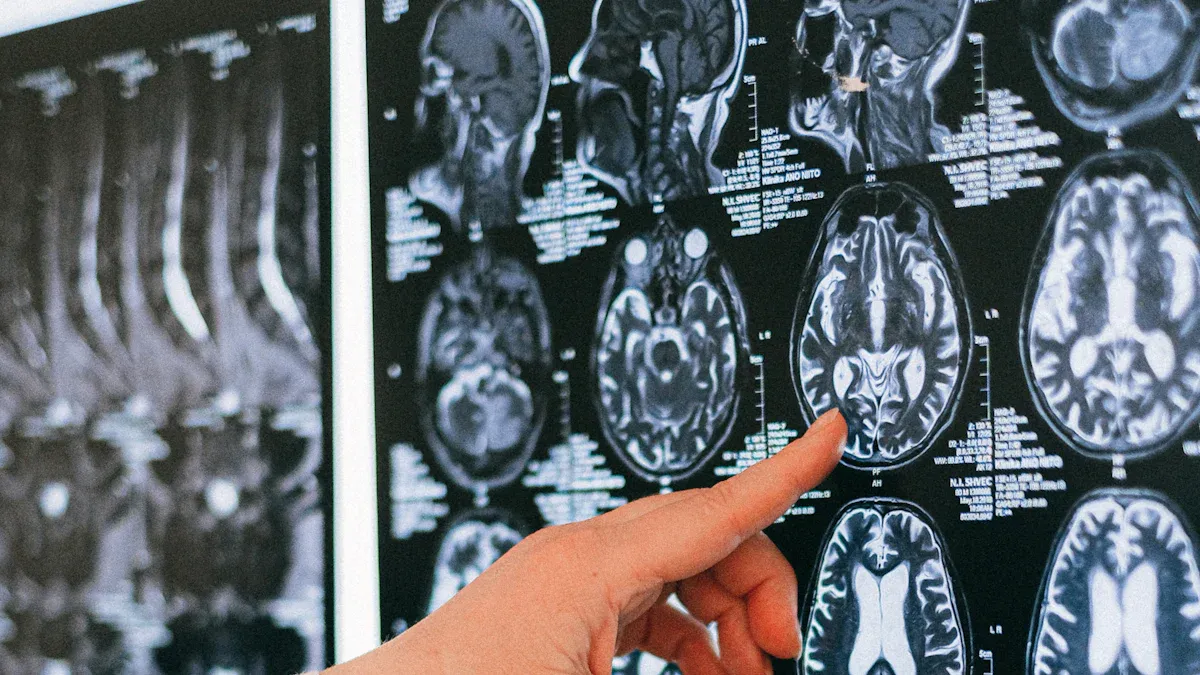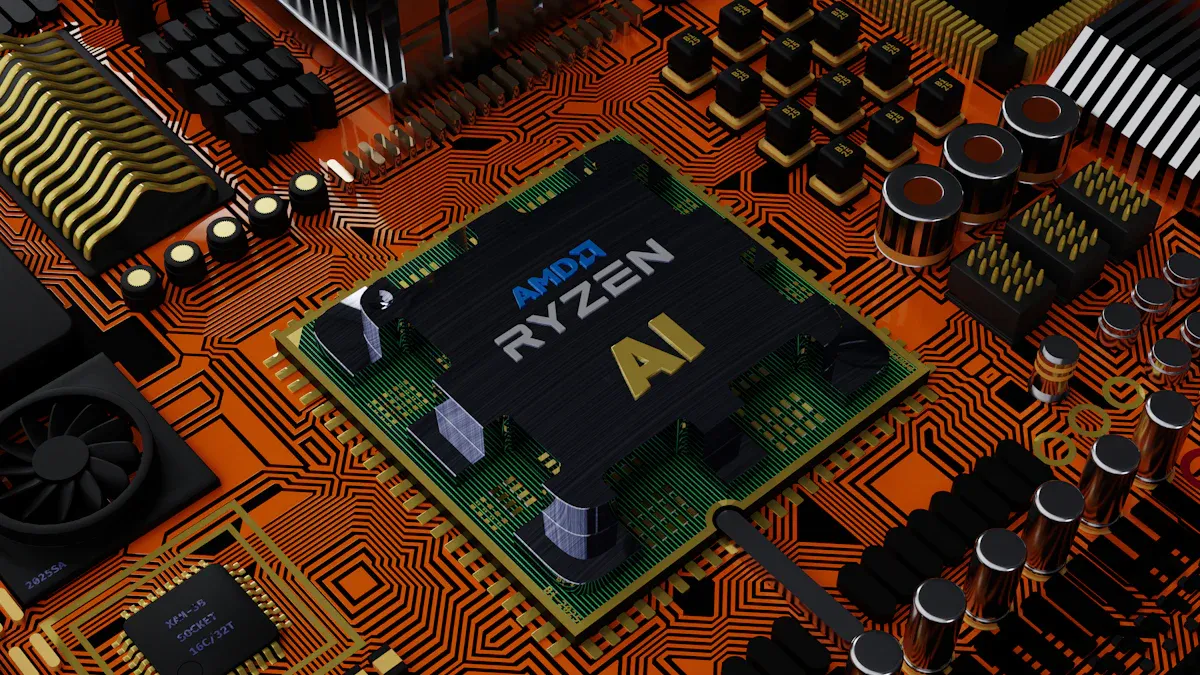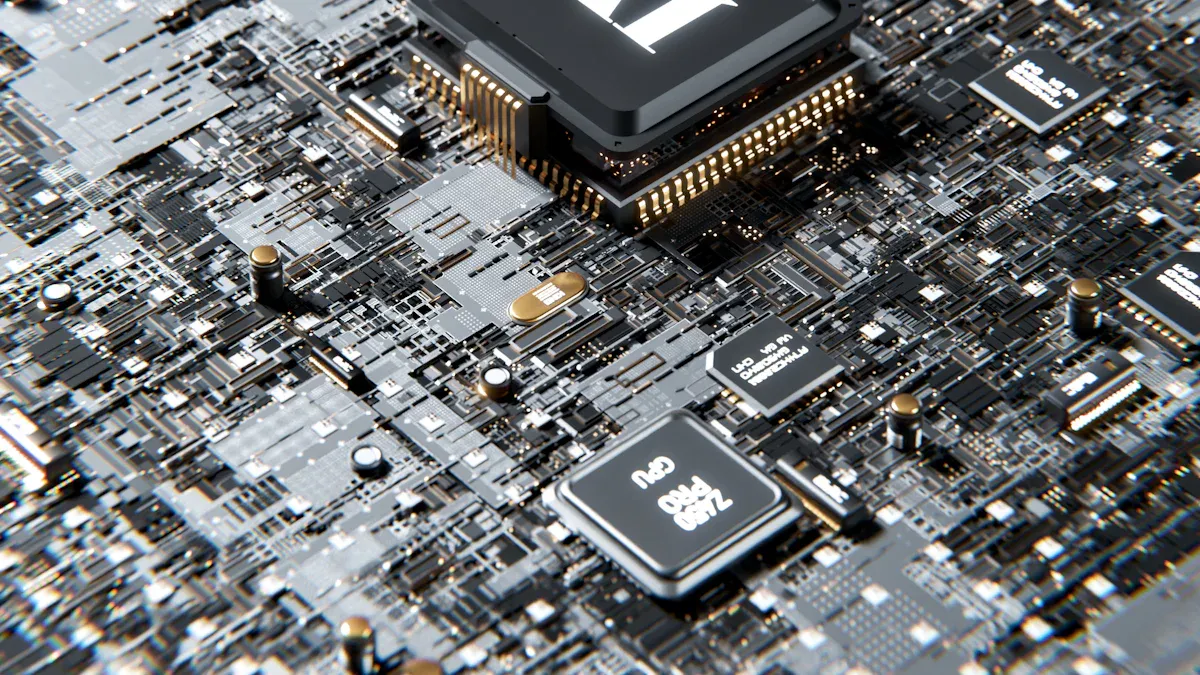Top Innovations in Medical Image Processing Chips in 2025

The year 2025 is significant for healthcare technology. A new medical image processing chip offers amazing features. These chips utilize smart technology to enhance diagnosis accuracy. They quickly process images, providing faster results. Their energy-saving design consumes less power and benefits the planet. Small sizes allow them to fit into portable devices for easier use. These advancements improve care, making diagnoses and treatments better and more accessible.
Key Takeaways
Medical image chips make diagnoses faster and more accurate. They help doctors find diseases sooner, improving patient health.
AI in these chips lets images be analyzed instantly. This helps doctors decide quickly, especially during emergencies.
New chip designs use less energy to save power. This cuts costs and helps protect the environment.
Smaller chips make portable and wearable devices possible. These devices bring healthcare to faraway places, helping more patients.
3D imaging shows clear pictures of the body. It helps find diseases early and creates custom treatment plans.
Medical Image Processing Chips in 2025
Role in Modern Healthcare
Medical image chips are now key tools in healthcare. They help doctors by making diagnoses faster and more accurate. These chips are used in machines like CT and MRI scanners. With AI, they improve image quality and speed up scans. For example:
They make PET images clearer and lower X-ray doses in CT scans.
They use special systems to make CT images sharper.
These improvements help doctors find diseases earlier and plan treatments better. The chips also handle big data quickly, making telemedicine more dependable for remote care.
Evolution and Technological Milestones
The history of medical image chips is full of progress. Early breakthroughs led to today’s advanced technology. For example:
Year | Key Achievement |
|---|---|
Siemens and Hitachi made the first translate-rotate head scanners. | |
1974 | Robert Ledley created the first body scanner at Georgetown University. |
1974 | Ohio Nuclear launched the DeltaScan 50, a two-slice body scanner. |
1974 | EMI 5000 scanner with 30 detectors was installed in a UK hospital. |
1975 | The US got its first two EMI 5005 scanners, improving CT scans. |
1975 | Technicare's Delta Scan became popular for faster scans and better software. |
Modern chips, like those using ARM Cortex-A76 and Cortex-A55, are a big step forward. They mix AI with energy-saving designs, perfect for today’s healthcare needs. These chips also work with DDR4/DDR5 memory and have advanced GPUs for better images.
The growth of these chips shows a focus on helping patients. Each step has brought faster, clearer, and more available medical imaging.
Key Innovations in Medical Image Processing Chips

AI Integration for Diagnostic Accuracy
AI has changed how medical image chips work. These chips now use AI to study medical images carefully. For example, AI finds tiny details in images that people might miss. This helps doctors spot diseases like cancer early. It makes diagnoses more accurate and reliable.
AI also helps predict health problems. By studying past images, AI chips can guess how a disease might grow. They can suggest treatments made just for the patient. This improves care and makes work easier for doctors. These chips are trusted for giving steady and correct results.
Real-Time Processing for Faster Results
Speed is very important in medical imaging. Real-time processing lets chips give results quickly. They use smart systems to study images fast. Doctors can see clear pictures right away. This helps them make quick choices, especially in emergencies.
Real-time tools also fix image problems as they happen. This saves time and keeps things running smoothly. For example, in research studies, these tools make sure data is correct and ready fast. These chips are great for giving quick and accurate results, which helps patients get better care.
Energy Efficiency and Sustainability
Modern chips use less energy but still work well. For example, MRI chips use very little power for many tasks. They are much more efficient than regular computer processors. CT chips are even better at saving energy.
Using less power lowers costs and helps the environment. These chips reduce pollution and support global green goals. You can trust that these chips improve healthcare while also protecting the Earth.
Miniaturization for Wearable and Portable Devices
Making medical imaging chips smaller has changed healthcare. Now, tiny chips power devices you can hold or wear. These small gadgets help doctors give better care anywhere, even far from hospitals.
Modern portable and wearable devices use advanced technology to stay small but work well. For example:
Small ultrasound machines are easier to carry than big ones.
Wearable ultrasound tools are safer and cost less to use.
Flexible ultrasound parts save energy while keeping images clear.
These tools give sharp images quickly, whether at home or in a clinic. Doctors can check your health often, helping find problems early and treat them faster.
Smaller devices now use AI to study images right away. AI works inside these gadgets to give quick answers to doctors. This means less need for big computers and faster results. For example, AI tools in wearable devices can spot heart issues or check lung health.
Portable devices bring healthcare to places that need it most. Imagine a doctor in a small village using a handheld ultrasound to help a patient. This is possible because of smaller, energy-saving medical imaging chips.
Still, making devices smaller while keeping them powerful is hard. Engineers must use smart designs and flexible materials to solve this. As technology improves, expect even tinier devices that work better, bringing healthcare closer to everyone.
Applications of 3D Medical Image Processing

Better Diagnoses and Early Disease Detection
3D medical imaging has changed how doctors find diseases. It shows clear, detailed pictures of the body. This helps doctors spot problems sooner and more accurately. Early treatment can start faster, giving patients a better chance to recover.
Doctors use special tools to study these images. Methods like texture checks and volume measurements help understand tissues. These tools track how diseases grow and how treatments work. For example:
Doctors can watch changes in the body over time.
They can see if tumors grow or if conditions like aneurysms worsen.
Comparing 3D images taken at different times shows how treatments, like chemotherapy, are helping.
Studies show 3D imaging improves early detection. For example:
Cancer Type | Early Detection Tool | Survival Rate (Stage 1) | Survival Rate (Stage 4) | How 3D Imaging Helps |
|---|---|---|---|---|
Lung Cancer | Low-dose CT scans | 5% | Cuts lung cancer deaths by 20% vs chest x-rays | |
Breast Cancer | MRI, ultrasound, breast tomosynthesis | 98% | N/A | Boosts accuracy and lowers false positives |
These tools make diagnoses more accurate and improve patient care.
Helping Surgeons Work More Precisely
In surgeries, being exact is very important. 3D imaging helps surgeons plan and perform operations better. This leads to faster healing and better results for patients.
For example, before jaw surgeries, 3D images help surgeons plan steps. Patients recover quicker and feel less pain. In complex face surgeries, 3D imaging shows bone problems clearly. This helps surgeons fix issues and improve looks and function.
Even in cosmetic surgeries like liposuction, 3D planning works well. Studies show up to 80% of fat stays after surgery. Patient satisfaction rates are often over 90%. These examples show how 3D imaging makes surgeries safer and more effective.
Custom Treatments Made Just for You
Personalized medicine creates treatments based on your needs. 3D imaging plays a big role in this. It makes detailed models of your body to help doctors plan better care.
One exciting use is 3D bioprinting. This technology builds body parts that act like real ones. It’s great for making custom implants and testing new medicines. For example:
3D bioprinting helps test drugs by creating realistic body models.
It builds structures that look like human tissues, improving treatment success.
These advancements mean treatments are more accurate and fit your condition. With 3D imaging, healthcare becomes smarter, faster, and more personal.
Telemedicine and Remote Monitoring Integration
Telemedicine lets you get care without going to a hospital. This is possible because of advanced medical image processing chips. These chips make telemedicine easier and more dependable.
3D imaging helps telemedicine by showing clear pictures of your body. Doctors can study these images from far away. You can talk to your doctor online while they check your images. This means faster advice and treatment from home.
Note: 3D imaging helps doctors find health problems early. Early detection leads to quicker recovery and better health results.
Wearable devices use these chips to watch your health all the time. For example, they can track your heart rate and send updates to your doctor. If something seems wrong, your doctor can reach out quickly. This helps manage long-term health issues better.
Here’s how 3D imaging improves telemedicine:
Better Access to Care: Get medical help even in faraway places.
Saves Money: Fewer trips to the hospital mean less cost and time.
More Involvement: Learn about your health and manage it better.
These chips also work with AI to study health data fast. AI gives doctors helpful information for making smart choices. Together, AI and telemedicine give you accurate and custom care.
Benefits and Challenges of Medical Image Processing Chips
Faster and More Accurate Diagnoses
Medical image chips have changed how doctors find health problems. These chips study images quickly, helping doctors decide faster. For example, they process 3D images in real-time to spot diseases like cancer early. This speed helps you get the right care without waiting too long.
The chips also make results more accurate. They use smart systems and AI to find tiny issues in images. This lowers the chance of mistakes and gives you reliable answers. By being both fast and precise, these chips make healthcare better and easier to trust.
Better Health Results for Patients
When doctors find problems faster, your treatment works better. With 3D imaging, they can make detailed pictures of your body. These pictures help plan surgeries or treatments just for you. For example, surgeons can use them to prepare steps, making recovery quicker and safer.
These chips also help with custom treatments. They study your health history and images to suggest the best care. This means your treatment fits your needs perfectly. AI makes this even better by guessing how diseases might grow. This gives you a clearer plan to get healthy.
Problems in Making and Scaling Chips
Making these chips isn’t easy and costs a lot. Special materials used in production make up over 40% of costs. Small companies find it hard to compete because of high expenses and strict rules. This makes it tough to produce enough chips for everyone.
The process to make chips is also tricky. For instance, growing pure crystals for chips often fails 18% of the time. This raises costs and limits how many chips are available. To fix this, companies need better ways to make chips and lower material costs. Solving these problems will help more people benefit from this amazing technology.
Ethical and Regulatory Considerations
Using advanced tools like 3D medical imaging needs careful rules. These rules keep patients safe and build trust. You might wonder how these chips are checked to protect you. Let’s look at the main guidelines that control their use.
Regulatory Frameworks
Groups have made rules to guide 3D medical imaging chips. These rules focus on safety, risks, and fair use. Here’s a simple summary:
Regulatory Framework | What It Does |
|---|---|
Made by doctors in Australia and New Zealand in 2019. It helps train doctors and set rules for using AI in healthcare. | |
Therapeutic Goods Administration (TGA) | Updated rules in 2021 for software-based medical tools. It uses a risk-based system to check AI devices. |
National Medical Products Administration (NMPA) | Shared rules in 2019 and 2021 for AI tools. It checks data quality, risks, and how AI tools are managed over time. |
Evidence Standards Framework for Digital Health Technologies | Created by NICE and NHS England in 2019. It sets rules for apps and digital health tools. |
These rules make sure 3D imaging chips are safe and work well.
Ethical Considerations
Adding AI to healthcare raises important questions. You might ask, "How do these tools stay fair and clear?" Here are some key ideas:
Training doctors to use AI safely and wisely.
Making clear rules for AI in healthcare.
Keeping patients safe and managing risks with AI tools.
These ideas make sure the technology helps without breaking ethical rules. For example, AI must explain how it makes decisions. This helps doctors trust the results and gives you accurate answers.
As 3D imaging grows, balancing new ideas with rules is key. These steps protect you while letting healthcare improve responsibly.
The new medical image chips in 2025 have changed healthcare. These chips make diagnoses more accurate and faster. They also help reduce mistakes in finding health problems. AI technology helps by automating tasks and combining data for better results. Here’s how they help:
Key Improvement | How It Helps Healthcare |
|---|---|
AI tools are as good as experts at finding diseases in images. | |
Fewer diagnostic mistakes | AI lowers the chances of wrong or missed diagnoses, helping patients get treated sooner. |
Faster diagnostic processes | AI studies images much quicker than people, which is vital in emergencies. |
Easier reporting and paperwork | AI creates reports automatically, saving time and reducing extra work for doctors. |
Combining diagnostic information | AI merges data from different sources to give clearer and more accurate results. |
Keep learning about these changes. They will improve patient care and make healthcare smarter and easier for everyone.
FAQ
What do medical image processing chips do?
These chips handle images from CT scans and MRIs. They help doctors see clear pictures of your body. This helps find health issues early and plan treatments better.
How do 3D medical image chips help healthcare?
They make detailed 3D pictures of your body. These pictures help doctors find diseases early and do surgeries more accurately. They also allow treatments made just for you.
Can AI tools in medical imaging replace doctors?
No, they help doctors by studying images faster and better. AI tools improve accuracy but doctors still make the final decisions and care for patients.
What is automated image reading?
It’s when software looks at medical images without human help. This makes diagnoses quicker and reduces mistakes. You get faster and more accurate results.
How does imaging software work with these chips?
The software uses data from the chips to make clear images. It improves image quality and gives helpful details for better care and treatment planning.
See Also
Top Developments Influencing Analog IC Sector By 2025
New Innovations Driving Automotive Chip Technology Forward
Guide to Integrating Smart Lighting Using MCUs in 2025
Exploring Low Power IoT Chips And Their Uses
A Comprehensive Overview of Communication Chips Functionality
